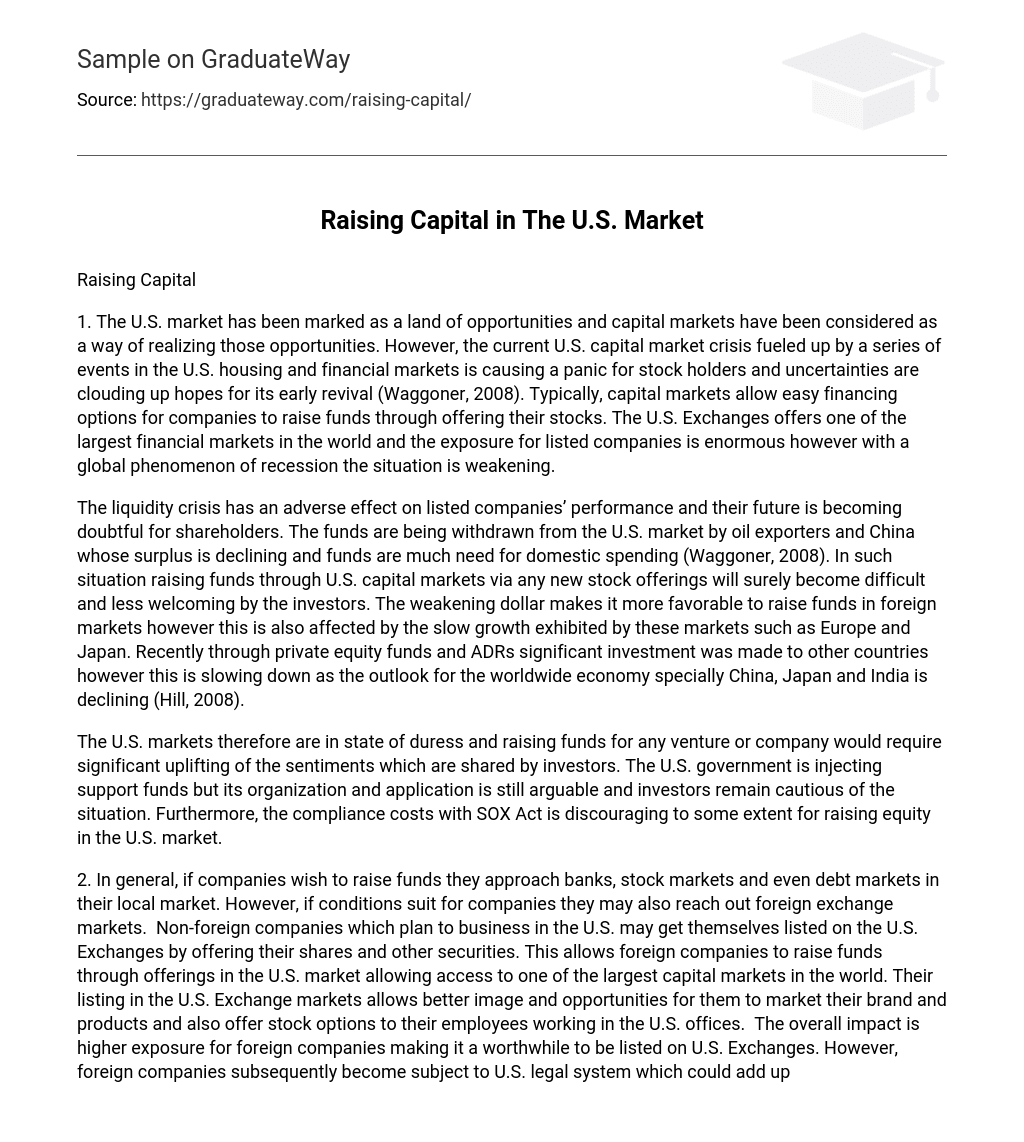Raising Capital
1. The U.S. market has been marked as a land of opportunities and capital markets have been considered as a way of realizing those opportunities. However, the current U.S. capital market crisis fueled up by a series of events in the U.S. housing and financial markets is causing a panic for stock holders and uncertainties are clouding up hopes for its early revival (Waggoner, 2008). Typically, capital markets allow easy financing options for companies to raise funds through offering their stocks. The U.S. Exchanges offers one of the largest financial markets in the world and the exposure for listed companies is enormous however with a global phenomenon of recession the situation is weakening.
The liquidity crisis has an adverse effect on listed companies’ performance and their future is becoming doubtful for shareholders. The funds are being withdrawn from the U.S. market by oil exporters and China whose surplus is declining and funds are much need for domestic spending (Waggoner, 2008). In such situation raising funds through U.S. capital markets via any new stock offerings will surely become difficult and less welcoming by the investors. The weakening dollar makes it more favorable to raise funds in foreign markets however this is also affected by the slow growth exhibited by these markets such as Europe and Japan. Recently through private equity funds and ADRs significant investment was made to other countries however this is slowing down as the outlook for the worldwide economy specially China, Japan and India is declining (Hill, 2008).
The U.S. markets therefore are in state of duress and raising funds for any venture or company would require significant uplifting of the sentiments which are shared by investors. The U.S. government is injecting support funds but its organization and application is still arguable and investors remain cautious of the situation. Furthermore, the compliance costs with SOX Act is discouraging to some extent for raising equity in the U.S. market.
2. In general, if companies wish to raise funds they approach banks, stock markets and even debt markets in their local market. However, if conditions suit for companies they may also reach out foreign exchange markets. Non-foreign companies which plan to business in the U.S. may get themselves listed on the U.S. Exchanges by offering their shares and other securities. This allows foreign companies to raise funds through offerings in the U.S. market allowing access to one of the largest capital markets in the world. Their listing in the U.S. Exchange markets allows better image and opportunities for them to market their brand and products and also offer stock options to their employees working in the U.S. offices. The overall impact is higher exposure for foreign companies making it a worthwhile to be listed on U.S. Exchanges. However, foreign companies subsequently become subject to U.S. legal system which could add up the administrative work and expenses. But for companies meeting conditions for ‘Foreign private issuers’ can benefit from less strict disclosure requirements set out by SEC than U.S. Companies (Zabrosky & Manzoni, 2001).
Foreign companies other than of Canadian origin can enlist their stocks on U.S. Exchanges through ADR which was introduced in 1927. ADR is a stock that is traded like regular stocks in U.S. markets but represent a specified number of shares in a foreign company (Investopedia, 2008). Foreign companies planning to tap U.S. capital markets could do so only by depositing a specific number of securities with a bank or other depository holder and ADR having ownership interest in these securities. The main aim of ADR is to reduce administration costs associated with buying of shares which are traded at prices and current values from other countries. ADR offers benefits such as easy share transfers and conversion of dividends in foreign currencies (Zabrosky & Manzoni, 2001).
3. The U.S. companies like foreign companies listing in the U.S. capital markets can also enrol their securities on foreign capital markets. The benefits from listing on foreign markets can outweigh the disadvantages from it. As raising equity in the U.S. capital markets is becoming difficult due to the compliance to rules and regulations is adding to the cost of offering and the economic conditions are to large extent grave and the liquidity crisis becoming uncontrollable in the U.S. economy, many U.S. companies are seeking opportunities in the foreign capital markets to raise equity. This provides access to economies which are less hit by the current liquidity problems. U.S. companies can get their offerings listen foreign markets for raising funds as this gives an opportunity especially for small caps to raise funds in markets which offer easy terms and conditions such AIM. AIM allows companies to go public at lower compliance costs and less rigid risk-averse conditions that exist in the U.S. markets (Johansmeyer, 2008). However, this also raises questions about compliance to rules and regulations of those markets with cost of accounting and reporting increasing. Furthermore, issues regarding duty on remittance and taxation may discourage companies. Current weakening of dollar makes it favourable for foreign firms to invest in U.S. companies implying greater liquidity and listing of shares on foreign markets encourages this.
References
Hill, P. (13 Nov 2008). Chinese Stimulus Spree Costs U.S. Capital; Surplus Funds Stay at Home. The Washington Post. Accessed on 5 Nov 2008 from <http://www.knowledgeplex.org/news/2653771.html>
Investopedia.com. (2008). American Depository Rates. Accessed on 5 Nov 2008 from < http://www.investopedia.com/terms/a/adr.asp>
Johansmeyer, T. R. (2008). Alternatives to the American IPO: Listing on AIM. Swiss Management Center. Accessed on 5 Nov 2008 from <http://www.swissmc.ch/article/17/alternatives_to_the_american_ipo_listing_on_aim>
Waggoner, J (16 Sept 2008). Market fallout: Selling off bad holdings, raising money will be difficult. USA Today. Accessed on 5 Nov 2008 from <http://www.tucsoncitizen.com/ss/byauthor/96833>
Zabrosky, A. W. & Manzoni Jr, C. R. (2001). Non U.S. Companies: Public Stock Offerings, Listings and SEC Disclosure in the U.S. Accessed on 5 Nov 2008 from <http://www.drinkerbiddle.com/files/Publication/59304f29-d32a-43d4-8a2c-47e4dd62165e/Presentation/PublicationAttachment/a54d0a67-b502-4405-b6f0-316c0a5fe071/NonUSCompanies.pdf>





